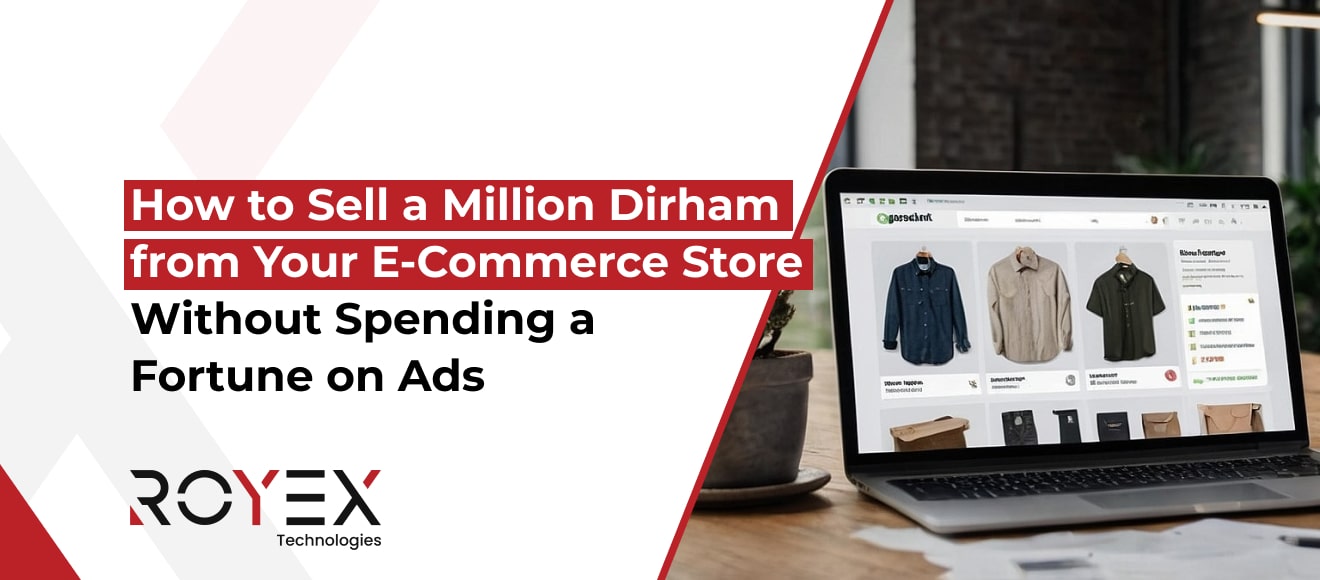
How to Sell a Million Dirham from Your E-Commerce Store — Without Spending a Fortune on Ads
Hitting AED 1,000,000 in revenue from your e-commerce store is a big, exciting milestone — and it’s absolutely achievable without burning cash on paid ads. This guide breaks down exactly how to get there with smart product choices, conversion-driven UX, high-leverage organic channels, retention tactics, partnerships, and a step-by-step playbook you can implement now. I’ll include realistic numbers, a sample roadmap, and the KPIs you must track.
Quick framing: what “one million dirham” means in practice
AED 1,000,000 is a clear revenue target. How you hit it depends on three simple levers every e-commerce business controls:
-
Traffic — how many visitors you get to your store.
-
Conversion rate (CVR) — what percentage of visitors buy.
-
Average order value (AOV) — how much each buyer spends on average.
Revenue = Traffic × CVR × AOV
Work on any of those levers and you move the needle. Below we’ll break down practical, low-cost ways to grow each lever and stack them so you can reach AED 1,000,000 without a huge ad budget.
The math (realistic examples)
Let’s run three simple scenarios to show how different approaches reach the same goal.
Scenario A — Higher volume, lower AOV
-
Target revenue: AED 1,000,000
-
AOV: AED 200
-
Required orders = 1,000,000 / 200 = 5,000 orders
-
If CVR = 1.5% → needed traffic = 5,000 / 0.015 = 333,333 visitors
Scenario B — Mid AOV, better conversion
-
AOV: AED 400
-
Orders needed = 2,500
-
If CVR = 2.5% → traffic = 2,500 / 0.025 = 100,000 visitors
Scenario C — High AOV, high retention
-
AOV: AED 1,000
-
Orders needed = 1,000
-
If CVR = 3% → traffic = 1,000 / 0.03 = 33,333 visitors
Which should you choose? That depends on your product, margin, and what channels you can access cheaply. In practice, the fastest path is a combination: raise AOV (bundles, upsells), improve conversion (CRO), and get efficient organic traffic.
Reality check: benchmarks and what they mean for your plan
-
Average e-commerce conversion rates have been around the mid single digits to low single digits depending on source; many stores see ~1.5% as an overall average, while more optimized sites reach 2–4% or higher. Use this as a baseline to set realistic traffic goals. Oberlo
-
Cart abandonment is a massive drag: studies show nearly 70% of carts are abandoned—this is where recovery tactics (email, SMS, on-site prompts) can reclaim a big chunk of revenue. Fix checkout friction and implement recovery flows as a priority. Baymard Institute+1
-
Globally e-commerce continues to grow steadily (single-digit annual growth recently), so building organic assets and customer relationships pays longer-term compounding dividends. Shopify
-
The UAE (your regional context if you target AED buyers) shows strong online retail momentum — the local e-commerce market is substantial and growing year over year, so local investment in logistics, UX for Arabic/English, and marketplace presence is worth the effort. Pro Carrier+1
(Those four facts will anchor our recommendations below. Use them to prioritize conversion and retention over ad-spend.)
Step 1 — Choose the right products and pricing strategy
A. Pick products with good unit economics
-
Margin matters: to scale to AED 1M profitably, choose SKUs with healthy gross margins after cost of goods sold (COGS), shipping, and basic overhead.
-
Avoid ultra-low margin commodity items unless you have a differentiated distribution or massive volume plan.
B. Find “AOV boosters”
-
Offer bundles, kits, and multi-buy discounts.
-
Use limited-time bundles (e.g., “Buy 2, get 20% off”).
-
Offer complementary products at checkout (1-click upsells): they’re cheap to implement and lift AOV significantly.
C. Test premium and subscription variants
-
Add a subscription option for consumables — subscriptions increase lifetime value (LTV) dramatically.
-
Offer a premium version with higher features/benefits and a higher price tag.
D. Nail your pricing psychology
-
Price tiers (Good / Better / Best) increase conversion and AOV.
-
Use charm pricing and value framing (e.g., show how much they save per month).
Step 2 — Optimize your conversion rate (CRO): quick wins that cost little
With average conversion rates low across many stores, an incremental lift in CVR multiplies revenue without any extra traffic.
Low-cost CRO checklist
-
Clear, compelling product pages
-
High-quality photos (mobile first).
-
3–5 benefits at the top; specs lower down.
-
Social proof: reviews, ratings, user photos.
-
-
Urgency & scarcity (authentic)
-
“Low stock” alerts and timed promotions (only when true).
-
-
Simplify checkout
-
One-page or short multi-step checkout.
-
Guest checkout (no forced account creation).
-
Show shipping costs early.
-
Reduce form fields — Baymard tests show many checkouts have too many fields causing abandonment. Baymard Institute
-
-
Fast site performance
-
Mobile load time under 3 seconds; optimize images and hosting.
-
-
Trust signals
-
Secure badges, clear returns policy, contact info.
-
-
A/B testing
-
Test headlines, CTAs, layout, and images. Small lifts compound.
-
Typical CRO impact
-
Moving from 1.5% → 2.5% CVR is a ~66% increase in orders for the same traffic. That’s equivalent to buying more traffic but free if you execute CRO well.
Step 3 — Traffic without paying for ads (or paying minimally)
Paid ads work but can be expensive—especially to scale to AED 1M if you have low margins. Here are organic and low-cost channels that scale.
3.1 Search engine optimization (SEO) — the long game that compounds
-
Why it matters: Organic traffic is essentially “free” once earned and produces a stable acquisition channel.
-
Tactical SEO plan
-
Keyword strategy: target high-intent transactional keywords for product pages and informational keywords for blog/content that convert later.
-
Product page SEO: unique titles, structured data (rich snippets), canonicalization.
-
Content funnel: “how-to”, buying guides, comparison pages that funnel to product pages.
-
Technical SEO: site speed, mobile first indexing, XML sitemaps, schema.
-
-
Local SEO (for AED/UAE focus):
-
Use local schema, Arabic + English pages, UAE shipping/returns info, and Google Business Profile for local pickup/omnichannel foot traffic.
-
3.2 Content marketing — build authority & capture demand
-
Create content that matches shopping intent:
-
Buyer guides, “best of” lists, use cases, and comparison pages.
-
-
Publish evergreen content and update it (keeps ranking).
-
Repurpose: blog → email newsletters → social posts → LinkedIn/Medium republish.
3.3 Social media & community (organic first)
-
Identify 1–2 platforms where your buyers live (Instagram and TikTok are huge for product discovery; LinkedIn for B2B).
-
Post user-generated content (UGC), behind-the-scenes, and product demos.
-
Small creator partnerships: micro-influencers (5k–50k followers) often charge modest fees or product-for-post deals and have higher engagement/ROI than big influencers.
-
Use short video formats: they drive discovery and can be repurposed as ads later.
3.4 Marketplaces & social commerce
-
List on local/regional marketplaces (e.g., Noon, Amazon.ae) to leverage existing demand channels.
-
Use marketplace success to fuel your brand store and collect customer emails.
3.5 Partnerships and B2B channels
-
Partner with businesses that have complementary audiences for co-promotions.
-
Offer bulk deals to corporates, hotels, or retailers.
3.6 Referral & affiliate programs
-
Set up a lightweight affiliate/referral program: customers and small affiliates can drive consistent orders for a modest commission.
Step 4 — Capture and convert traffic with owned channels
Paid traffic costs money; owned channels give lifetime returns.
4.1 Email marketing (one of the highest ROI channels)
-
Build your list on day one with exit-intent popups, content upgrades, and on-site incentives.
-
Use lifecycle flows: Welcome series, cart recovery, browse abandonment, post-purchase nurturing.
-
Email is proven to have a very high ROI for e-commerce — treat it as your primary retention engine.
4.2 SMS/Mobile push
-
SMS open rates are extremely high; used responsibly it converts well for time-sensitive promos and recovery.
-
Obtain explicit consent and segment messages by behavior.
4.3 Loyalty & VIP programs
-
Reward repeat purchases with points, discounts, or early access.
-
VIP tiers encourage higher spend and frequency.
4.4 Reviews & UGC
-
Automate review requests post-purchase.
-
Showcase UGC on product pages and social ads to improve trust and CVR.
Step 5 — Control friction: logistics, returns, and customer experience
Everything you do on product pages and checkout is undone if delivery and returns suck.
Logistics checklist
-
Reliable shipping partners with tracking.
-
Clear shipping times and costs displayed upfront.
-
Free shipping threshold: for many stores, offering free shipping over a certain order value lifts AOV and conversion.
-
Easy returns/exchanges policy — make it frictionless. A good returns policy increases conversion.
Customer support
-
Chat (live or AI), clear FAQ, WhatsApp support (very popular in the UAE).
-
Fast responses build trust and reduce churn.
Step 6 — Use inexpensive paid tactics smartly (if/when to spend)
If you’ll spend, do it where ROI is trackable and incremental.
-
Retargeting — low CPMs and high intent: convert visitors who already showed interest.
-
Search ads for high-intent keywords (branded and bottom-of-funnel terms).
-
Sponsored product placements on marketplaces — often cheaper than broad social ads.
-
Creative testing on tiny budgets — run micro tests on social platforms and scale winners.
Use performance thresholds: don’t scale a channel unless CAC vs LTV makes sense.
Step 7 — Retention and lifecycle optimization (the multiplier)
Retention reduces the need for new acquisition. Small improvements here compound dramatically.
Key retention tactics
-
Post-purchase experience: order confirmations, shipping updates, and onboarding emails.
-
Cross-sell/upsell flows: suggest relevant add-ons in post-order pages and emails.
-
Win-back campaigns: target lapsed customers with personalized offers.
-
Subscription models for replenishable items.
LTV increases let you spend more on initial acquisition or hit revenue targets with lower traffic.
Step 8 — Conversion recovery: cart abandonment and browse abandonment
With cart abandonment near 70%, a good recovery funnel is high leverage.
Implement these immediately
-
Cart abandonment emails: 3-step sequence — reminder, social proof, deadline/discount.
-
SMS recovery: short, timely messages for cart recovery.
-
On-site recovery: exit-intent overlays with discount or free shipping.
-
Retargeting creatives showing the exact product left in cart.
Recovering even 10–15% of abandoned carts can add tens of thousands of AED to your revenue in a short time.
Step 9 — Measurement: what to track and how to read it
You can’t improve what you don’t measure. Keep tracking simple, actionable, and weekly.
Core KPIs
-
Traffic (sessions by channel)
-
Conversion rate (overall and by device)
-
Average order value (AOV)
-
Revenue (daily/weekly/monthly)
-
Customer acquisition cost (CAC) by channel
-
Customer lifetime value (LTV)
-
Repeat purchase rate
-
Cart abandonment rate
-
Gross margin % and net margin %
Analytics setup
-
Use Google Analytics (GA4) or equivalent; set e-commerce events for add-to-cart, checkout steps, purchase.
-
UTM tagging for campaigns.
-
A simple dashboard with revenue, orders, AOV, CVR, and top performing SKUs is invaluable.
Step 10 — A practical 12-week action plan to reach AED 1,000,000
Below is a focused 12-week sprint plan that stacks activities for rapid, low-cost revenue growth. Adjust based on your starting point and resources.
Weeks 1–2: Set foundation
-
Audit product pages, checkout flow, and site speed.
-
Implement basic CRO fixes (reduce fields, show shipping).
-
Set up analytics and UTM structure.
Weeks 3–4: Conversion & recovery
-
Build cart abandonment and welcome email flows.
-
Add one upsell/back-end offer.
-
Implement exit-intent capture and SMS signup.
Weeks 5–8: Traffic & content push
-
Launch 8–12 pieces of targeted content (buyer guides + how-tos).
-
Outreach to 10 micro-influencers for product posts (product-for-post deals).
-
List key SKUs on one marketplace (Noon or Amazon.ae).
Weeks 9–10: Partnerships & promotions
-
Start 3 co-marketing partnerships (complementary brands).
-
Run a time-boxed campaign (bundle + free shipping over threshold).
-
Test small retargeting budgets on social for cart recoveries.
Weeks 11–12: Scale what works & report
-
Ramp up the highest-ROAS channels (usually email + retargeting).
-
Optimize ad creatives based on top performing UGC.
-
Prepare a 90-day report: top SKUs, channels, CAC vs LTV, repeat rate.
Repeat cycles, continuously optimizing.
Cost modeling: how much you actually need to spend
You asked “without spending a fortune on ads.” That doesn’t mean spending zero — it means strategic, modest investments.
Example conservative budget spread for first year (illustrative)
-
Tech & hosting: AED 6,000–12,000
-
Content creation (monthly): AED 2,000–6,000
-
Small paid tests/retargeting: AED 5,000–20,000
-
Influencer/product seeding: AED 5,000–15,000
-
Email/SMS platform: AED 1,200–6,000
-
Logistics & returns buffer: variable
Total modest operating spend might be AED 20k–60k annually — minor compared to hitting AED 1M in revenue when you lean on organic and retention.
Realistic timeline to AED 1,000,000 (depends on starting point)
-
If you’re starting from zero (new store): 9–18 months with consistent content/SEO + marketplaces + retention strategies.
-
If you have existing traffic but low conversion: 3–9 months by focusing on CRO and retention.
-
If you already have repeat customers and decent AOV: 3–6 months scaling email + partnerships.
The variables: product-market fit, margins, and how aggressively you scale low-cost channels.
Common pitfalls and how to avoid them
-
Focusing only on acquisition: Without CRO and retention, acquisition is a money pit.
-
Fix: prioritize checkout experience and post-purchase flows first.
-
-
Discounting to buy growth: Constant discounting destroys margins and trains customers to wait.
-
Fix: use value adds (free shipping over threshold) and timed offers sparingly.
-
-
Ignoring mobile: Majority of browsing is mobile—slow/mobile-unfriendly sites lose conversions.
-
Fix: mobile responsive design and fast images.
-
-
Poor measurement: “I think” is not strategy.
-
Fix: set tracking, weekly KPI meetings, and data-driven experiments.
-
-
TOO many platforms at once: Spreading effort thin dilutes results.
-
Fix: pick 1–2 channels and dominate them before expanding.
-
Tactical playbook — 30 specific tactics you can implement this month
-
Add a 3-email cart recovery sequence (0h–48h–72h).
-
Introduce a “buy 2, save 15%” bundle.
-
Show live low-stock counts on product pages.
-
Reduce checkout form fields by 40%.
-
Add product review requests 5 days post-delivery.
-
Offer free shipping over AED X (AOV lift).
-
Implement one-click upsell post-purchase.
-
Create one high-value buyer’s guide (1,500–2,000 words).
-
Seed 5 product samples to micro-influencers for UGC.
-
Run a surprise VIP discount for repeat customers.
-
Add structured data to product pages for rich snippets.
-
Localize pages into Arabic + English.
-
Implement site search with suggestions and synonyms.
-
Offer WhatsApp customer support for quick conversions.
-
Add Trustpilot or local review widget.
-
Use exit-intent to collect email with a small incentive.
-
Speed optimize images and server (Core Web Vitals focus).
-
Add payment installment options (if appropriate).
-
Run A/B test on product page hero image.
-
Launch “Refer a friend” with AED credit reward.
-
Use dynamic product retargeting with the exact SKU on social.
-
Build a “best sellers” landing page for internal linking.
-
Promote limited-time bundles via SMS to engaged customers.
-
Create FAQ schema for search snippets.
-
Run a marketplace promo (sponsored product) for flagship SKU.
-
Add live chat bot with human fallback.
-
Create a “how to use” video for the top 3 SKUs.
-
Add badges for “fastest shipping” or “eco pack” if relevant.
-
Offer a “gift wrap” upsell during checkout (seasonal).
-
Audit fees (payment gateway/shipping) monthly to protect margins.
Sample KPI targets for a 12-month plan (benchmarks to aim for)
-
CVR: improve to 2–3% (if starting from 1–1.5%)
-
AOV: increase by 15–30% with bundles/upsell
-
Repeat purchase rate: 20–30%
-
Cart abandonment recovery rate (via email + SMS): recover 10–20%
-
Email list growth: 3–5% monthly
-
Organic search traffic: +20–50% year over year
These are realistic and conservative targets depending on starting point.
Case patterns (mini case studies — anonymized & hypothetical)
Case 1: Boutique skincare (starting CVR 1.2%, AOV AED 250)
-
Focus: CRO + email + subscription
-
Actions: simplified checkout, review amplification, subscription option, welcome + content emails.
-
Result (6 months): CVR to 2.4%, AOV to AED 320, subscriptions contributed 18% of revenue — revenue doubled without scaling ad spend.
Case 2: Home accessories (marketplace + D2C hybrid)
-
Focus: market listing optimization + bundles + micro-influencers
-
Actions: optimized Noon listings, cross-promos, UGC video library.
-
Result (9 months): Marketplace contributed 45% of sales; D2C conversion from content funnel increased; net revenue hit AED 1M with modest ad investment.
Crisis playbook — what to do if growth stalls
-
Revisit product-market fit (speak to customers).
-
Deep dive analytics for leaky funnels (which step drops highest %).
-
Run a 2-week content + email reactivation push to previous customers.
-
Short, unbranded tests on marketplaces to find demand signals.
-
Reassess pricing and shipping thresholds.
Frequently asked numbers (benchmarks & stats recap)
-
Average CVR: many stores hover around low single-digit percentages; use 1.5% as a conservative baseline and strive for 2–4% with optimization. Oberlo
-
Cart abandonment: roughly ~70%—a huge opportunity for recovery flows. Baymard Institute+1
-
Global ecommerce growth: ecommerce continues to grow year-over-year with mid-single-digit expansion in recent years—organic assets compound with time. Shopify
-
UAE market: UAE e-commerce shows strong growth and opportunity for AED denominated businesses; local market dynamics (logistics, Arabic/English UX, marketplaces) matter. Pro Carrier+1
How to forecast progress: a simple rolling model
Create a one-page spreadsheet with:
-
Monthly sessions by channel
-
CVR by channel
-
Orders = sessions × CVR
-
AOV by channel
-
Revenue = orders × AOV
-
CAC and LTV calculations
Update weekly and use this to decide where to allocate the next month’s spend. If email yields 3x ROAS while social retargeting is 1.3x, scale email automation and reduce wasted ad spend.
Quick UX checklist to finalize before scaling
-
Mobile speed <3s
-
Clear product benefits in first screen
-
Visible shipping and returns
-
1-click promo/coupon application
-
Multiple local payment methods (credit card, Apple/Google Pay, local wallets)
-
Visible phone/WhatsApp support
-
Trust badges & return policy
Final checklist — what to have in place before you scale
-
Solid analytics (events, funnels)
-
Cart abandonment + welcome flows live
-
A tested checkout (guest + express pay)
-
5–10 pieces of high-quality content
-
3 active acquisition channels (organic search, email, one social)
-
At least 1 marketplace presence (if relevant)
-
Logistics & returns SOPs
-
A/B testing framework
Why small spends + smart strategy beat “throwing money at ads”
Paid ads scale linearly with budget — and often eat margins. Organic, retention, CRO, partnerships, and marketplace play build defensible, compounding channels. Fixing conversion and retention gives you the option to spend later more profitably.
Why choose Royex for e-commerce development
If you want to move from strategy to execution — fast, reliable, and tailored to the UAE/GCC market — Royex brings the full stack you need:
1. End-to-end e-commerce expertise
Royex Technologies builds optimized e-commerce platforms (custom or headless) with a focus on performance, scalability, and conversion. We design product pages, checkout flows, and backend integrations with a conversion-first mindset.
2. Regional experience and localization
Royex knows the UAE and GCC landscape: marketplace ecosystems (Noon, Amazon.ae), logistics partners, Arabic + English UX best practices, and local payment methods. That local know-how means faster time to revenue for AED-focused stores.
3. Built for growth (not just launch)
We deliver:
-
SEO-friendly architecture and structured data.
-
Integrated email/SMS automation and CRM setups.
-
Fast hosting and performance tuning prioritized for mobile.
-
Analytics and dashboarding so you have the numbers to scale.
4. CRO and conversion engineering
Royex doesn’t just build a store; we build experiments. A/B testing, checkout optimization, and on-site conversion improvements are built into the development roadmap so your site converts from day one.
5. Integrations & automation
We integrate inventory, ERP, marketplaces, and shipping providers to reduce manual overhead and speed up order fulfillment — crucial for customer experience and margin protection.
6. Ongoing partnership & support
Beyond launch, Royex supports marketing execution, performance tuning, and product roadmap prioritization — exactly what you need to scale to AED 1,000,000 and beyond.
TL;DR — The playbook in 6 bullets
-
Fix conversion first (checkout, speed, trust). Small improvements = big revenue.
-
Increase AOV via bundles, upsells, subscriptions.
-
Capture owned channels: email & SMS are high ROI and underused.
-
Lean into organic: SEO + content + micro-influencers + marketplaces.
-
Recover abandoned carts — 70%+ abandon rate is a low-hanging fruit.
-
Measure everything and scale the channels with good CAC:LTV.
Established in 2013, Royex Technologies is a leading E-Commerce Web Design Company in Dubai that provides innovative solutions for small, medium, and large-scale companies. We specialize in responsive web development, mobile app development, CRM integration, AI solutions for website & mobile applications, and many more. Our extensive experience in mobile app development will help you to take your business to a high level.





